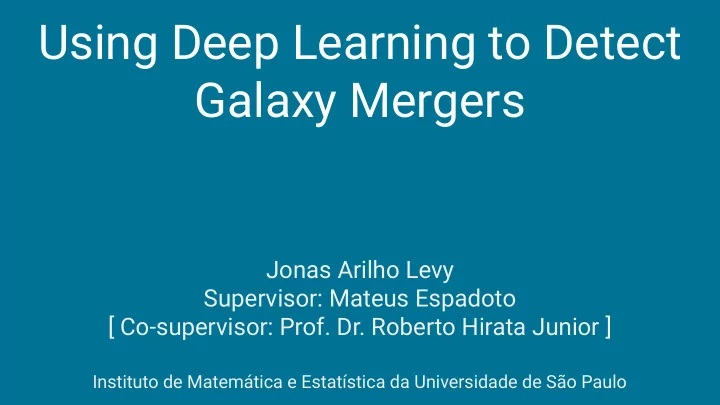

Using Deep Learning to Detect Galaxy Mergers Jonas Arilho Levy Supervisor: Mateus Espadoto [ Co-supervisor: Prof. Dr. Roberto Hirata Junior ] Instituto de Matemática e Estatística da Universidade de São Paulo
Contents: ● Objectives 3 ● Background 5 ● Architectures 9 ● Methods 13 ● Results 19 ● Conclusions 23 ● Bibliography 24
Objectives - Detect galaxy mergers using Deep Learning techniques - Investigate 3 Convolutional Neural Networks (CNNs) architectures - Compare learning from scratch and transfer learning - Outperform previous automatic detection methods Using Deep Learning to Detect Galaxy Mergers - Jonas Arilho Levy - 2019 3
Background
Astronomy - What is a galaxy merger? - How astronomers get imaging data? Using Deep Learning to Detect Galaxy Mergers - Jonas Arilho Levy - 2019 5
Image by ESA/Hubble available at https://www.spacetelescope.org/images/heic0810ac/
Deep Learning - Neural Networks - Gradient descent and backpropagation - Convolutional Neural Networks Using Deep Learning to Detect Galaxy Mergers - Jonas Arilho Levy - 2019 7
Architectures
VGG-16 - Created by the Visual Geometry Group at the University of Oxford (2014) [1] - 138 Million parameters 13 convolutional layers and 3 fully-connected layers - Using Deep Learning to Detect Galaxy Mergers - Jonas Arilho Levy - 2019 9
Inception-v3 Created by the Google AI team (2016) [2] - Inspired by the movie Inception and the quote “We need to go deeper” - - 24 million parameters, stacks dense blocks of convolutional layers and uses batch normalisation in auxiliary layers Using Deep Learning to Detect Galaxy Mergers - Jonas Arilho Levy - 2019 10
Densenet-121 - Created by Facebook AI Research (2017) [3] - Adds shortcuts among layers Only 0.8 Million trainable parameters - - Features a growth rate hyperparameter Using Deep Learning to Detect Galaxy Mergers - Jonas Arilho Levy - 2019 11
Methods
Dataset - 16000 RGB images from the Sloan Digital Sky Survey (SDSS) Data Release 7. - two classes: - Merger - Non-interacting Using Deep Learning to Detect Galaxy Mergers - Jonas Arilho Levy - 2019 13
Binary Classification Merger Non-interacting 14 Using Deep Learning to Detect Galaxy Mergers - Jonas Arilho Levy - 2019 14
Dataset Preparation 1. Loading and normalizing the images 2. Resizing the images 3. Splitting the dataset and augmenting the data Using Deep Learning to Detect Galaxy Mergers - Jonas Arilho Levy - 2019 15
Experiment 1: From Scratch 1. Use random initialization to the weights 2. Add top layers 3. Train using mini-batch SGD with a standard learning rate Using Deep Learning to Detect Galaxy Mergers - Jonas Arilho Levy - 2019 16
Experiment 2: Transfer Learning 1. Load the pre-trained CNN with weights 2. Add the top layers and use the ADAM optimizer to train only them 3. Fine-tune using mini-batch SGD with a small learning rate and momentum. Using Deep Learning to Detect Galaxy Mergers - Jonas Arilho Levy - 2019 17
Results
Experiment 1 Results VGG-16 Inception-v3 Densenet-121 95.87% 95.53% 96.10% Using Deep Learning to Detect Galaxy Mergers - Jonas Arilho Levy - 2019 19
Experiment 2 Results VGG-16 Inception-v3 Densenet-121 96.81% 36.82% 96.82% Using Deep Learning to Detect Galaxy Mergers - Jonas Arilho Levy - 2019 20
Comparing Experiments Architecture Experiment Precision Recall F1-Score 1 0.96 0.96 0.96 VGG-16 2 0.97 0.97 0.97 1 0.96 0.96 0.96 Inception-V3 2 0.25 0.37 0.20 1 0.96 0.96 0.96 Densenet-121 2 0.97 0.97 0.97 Using Deep Learning to Detect Galaxy Mergers - Jonas Arilho Levy - 2019 21
Comparing Results Method Precision Recall F1-Score Hoyos et al.(2012) [4] 0.92 0.29 0.44 Goulding et al.(2017) [5] 0.75 0.90 0.82 Ackermann et al.(2018) [6] 0.96 0.97 0.97 Experiment 1 0.96 0.96 0.96 Experiment 2 0.97 0.97 0.97 Using Deep Learning to Detect Galaxy Mergers - Jonas Arilho Levy - 2019 22
Conclusions - A high accuracy can be achieved - By using transfer learning there was a slight increase in performance - Reliable approach that outperforms previous methods Using Deep Learning to Detect Galaxy Mergers - Jonas Arilho Levy - 2019 23
Bibliography [1] Karen Simonyan and Andrew Zisserman. (2014) “Very deep convolutional networks for large-scale image recognition”. In: arXiv preprint arXiv:1409.1556. [2] Christian Szegedy et al. (2016) “Rethinking the inception architecture for computer vision”. In: Proceedings of the IEEE conference on computer vision and pattern recognition. 2016, pp. 2818–2826. [3] Gao Huang et al. (2017) “Densely connected convolutional networks”. In: Proceedings of the IEEE conference on computer vision and pattern recognition. 2017, pp. 4700–4708. [4] Hoyos et al. (2012) “A new automatic method to identify galaxy mergers–i. description and application to the space telescope a901/902 galaxy evolution survey”. In: Monthly Notices of the Royal Astronomical Society, 419(3):2703–2724. [5] Goulding et al. (2017) “Galaxy interactions trigger rapid black hole growth: An unprecedented view from the hyper suprime-cam survey”. In: Publications of the Astronomical Society of Japan, 70(SP1):S37. [6] Ackermann et al. (2018) “Using transfer learning to detect galaxy mergers”. In: Monthly Notices of the Royal Astronomical Society, 479(1):415–425. Using Deep Learning to Detect Galaxy Mergers - Jonas Arilho Levy - 2019 24
Thank You
Using Deep Learning to Detect Galaxy Mergers Jonas Arilho Levy Supervisor: Prof. Dr. Roberto Hirata Junior [ Co-supervisor: Mateus Espadoto ] Instituto de Matemática e Estatística da Universidade de São Paulo
Recommend
More recommend